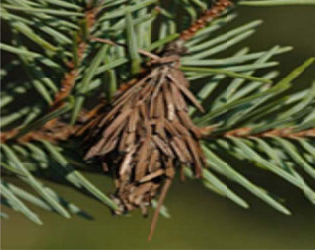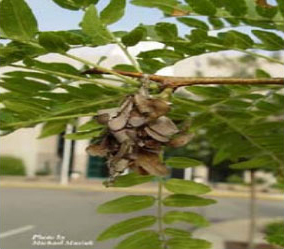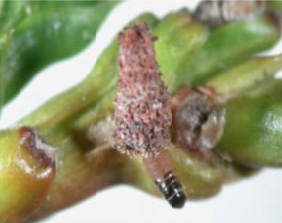Bagworms attack both deciduous and evergreen trees. Some of the more common evergreen host plants include Cedar (Thuja), fir (Abies), hemlock (Tsuga), juniper (Juniperus), pine (Pinus) and spruce (Picea). Deciduous host plants include black locust (Robinia pseudoacacia), honeylocust (Gleditsia triacanthos), sweetgum (Liquidambar styraciflua) and sycamore (Platanus occidentalis).
The bagworm (Thyridopteryx ephemeraeformis) is the larval stage of a moth native to Pennsylvania that is reported to feed on over 100 different plants.
DAMAGE:
The young larvae feed on the upper epidermis leaving small brown spots on the leaves. Older larvae strip evergreens of their needles and consume whole leaves of susceptible deciduous species, leaving only the larger veins. Unfortunately, the presence of bagworms often goes unnoticed until they are mature and the damage is extensive.
DESCRIPTION AND LIFE CYCLE:
The cone-shaped bags, which they form, easily identify bagworms. These are carefully interwoven using silk and bits of leaves and twigs from the host plant resulting in a well-disguised covering. The tops of the young larvae are shiny black and their body undersides are dull amber. When fully grown, the bagworms are a dull, dirty, gray with darker markings toward the head. The adult male develops into a moth that can fly, but the female remains grub-like and stays inside the bag.
Winter: The eggs over-winter inside the bag made by the previous year’s female.
Spring: Egg hatch occurs from late May to early June, at which time the larvae crawl out in search of food. Each constructs a small bag around its hind parts with silk and plant material.
Summer: Feeding, growth and molting continue until August at which time the mature larvae attach themselves so that they are head down in the bag. They remain there for about 4 weeks as pupae.
Fall: During September and early October, the female releases a sex attractant pheromone and the males leave their cases and fly to the female bags to mate. Females lay 500-1000 eggs in each bag. There is one generation per year in Pennsylvania.
CONTROL MEASURES:
Manual
In the fall, winter and early spring, before the eggs have hatched, the bags can be picked off the plant and destroyed.
Biological
The bagworm has some natural enemies, such as certain species of birds that are able to tear open the bags and feed on the larvae, in addition to insect predators and parasitoids. Unfortunately, this will not usually control the bagworm population.
Chemical
Insecticides are more effective when the larvae are small and just emerging from the over-wintering bag. Larger larvae and molting larvae are not easily killed.




Authored by:
Katherine Mazzey, Penn State Extension Program Assistant
Michael Masiuk, Extension Educator, Penn State Univeristy, Allegheny County
